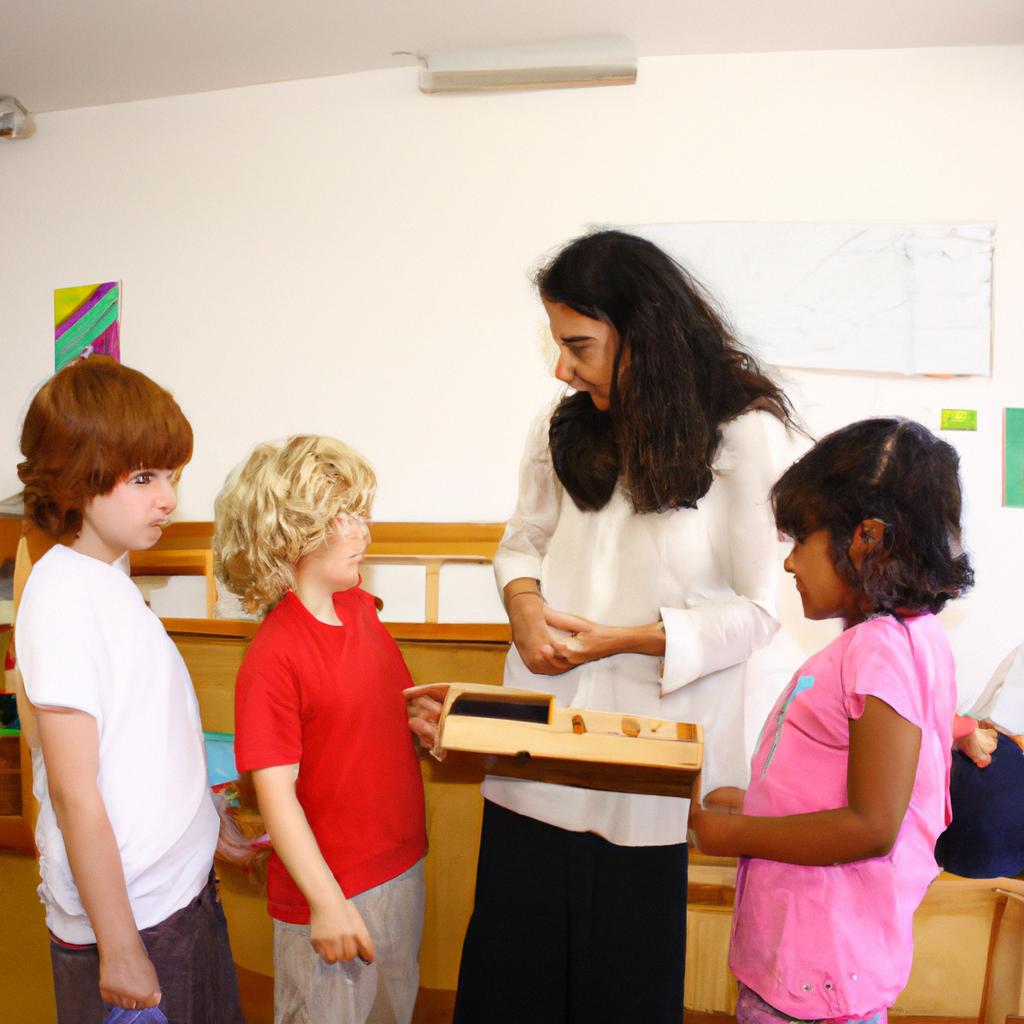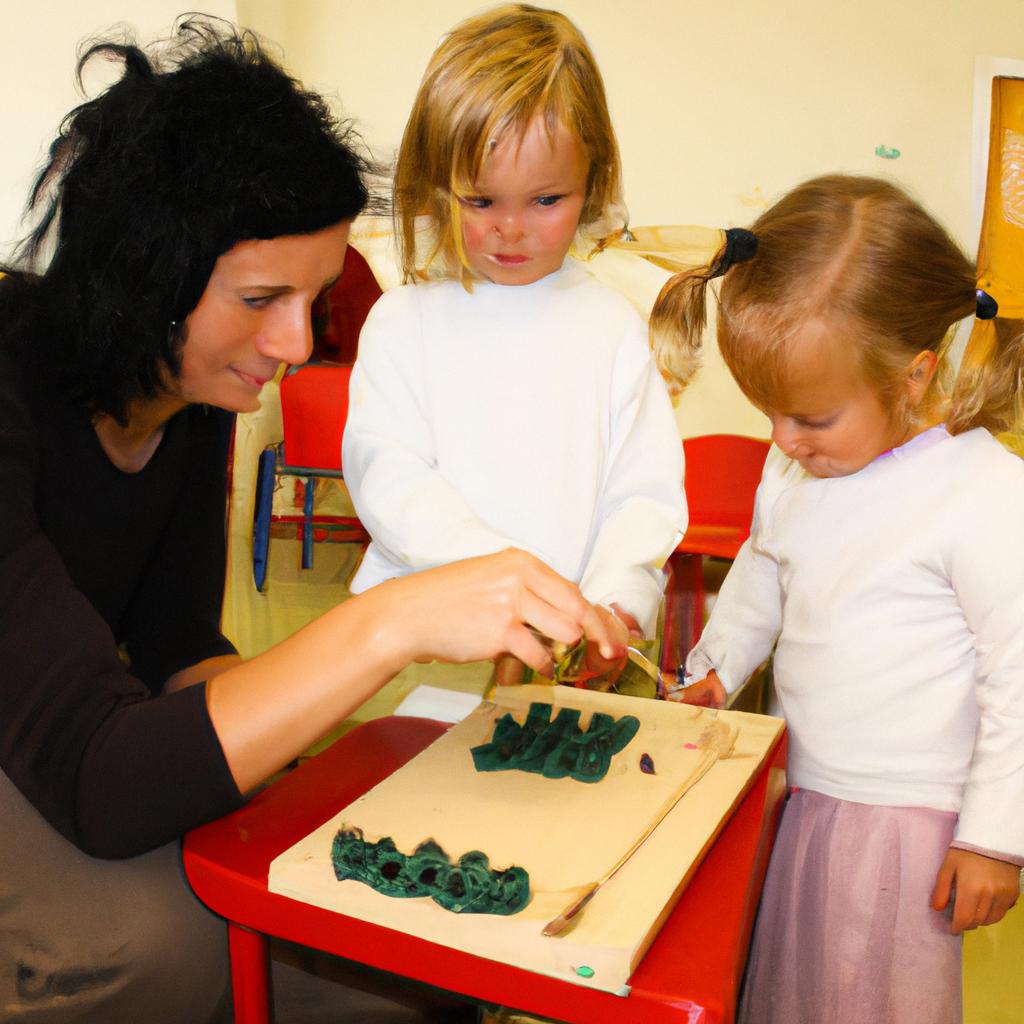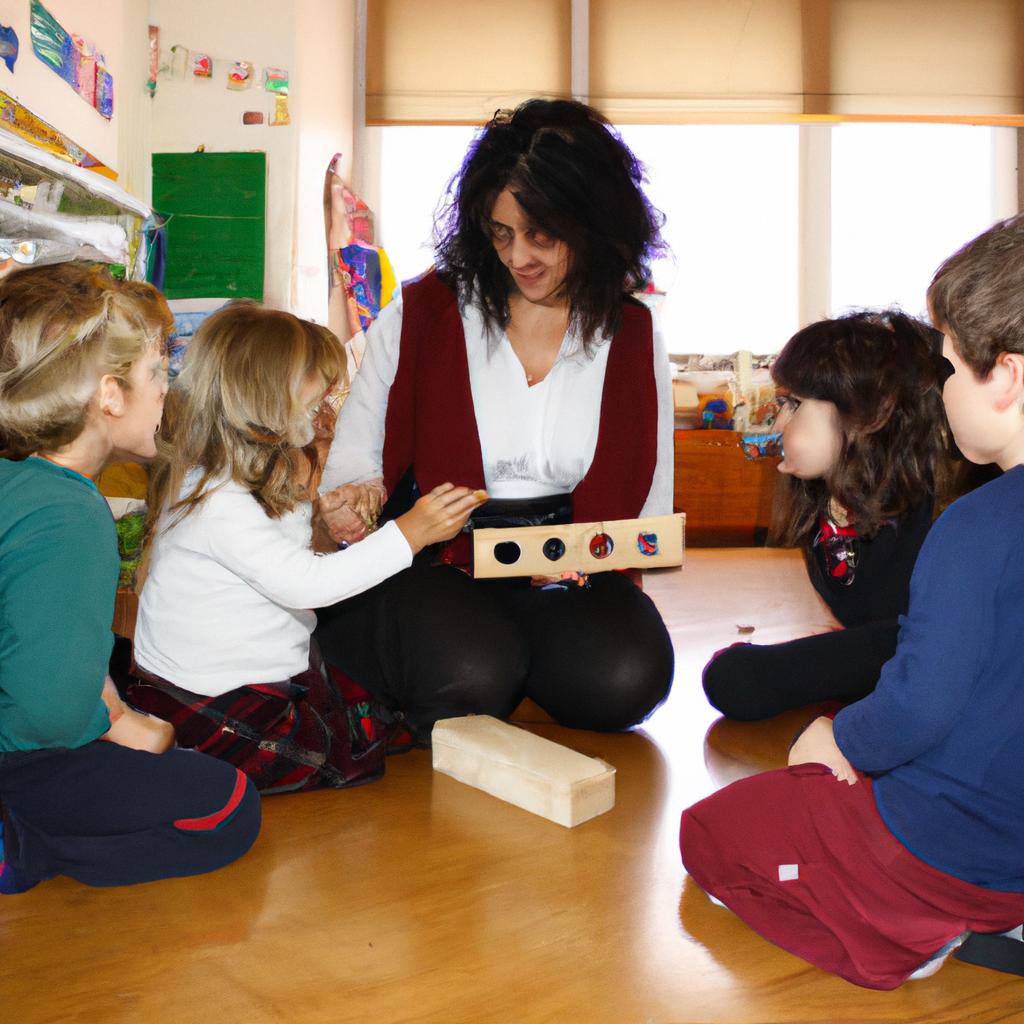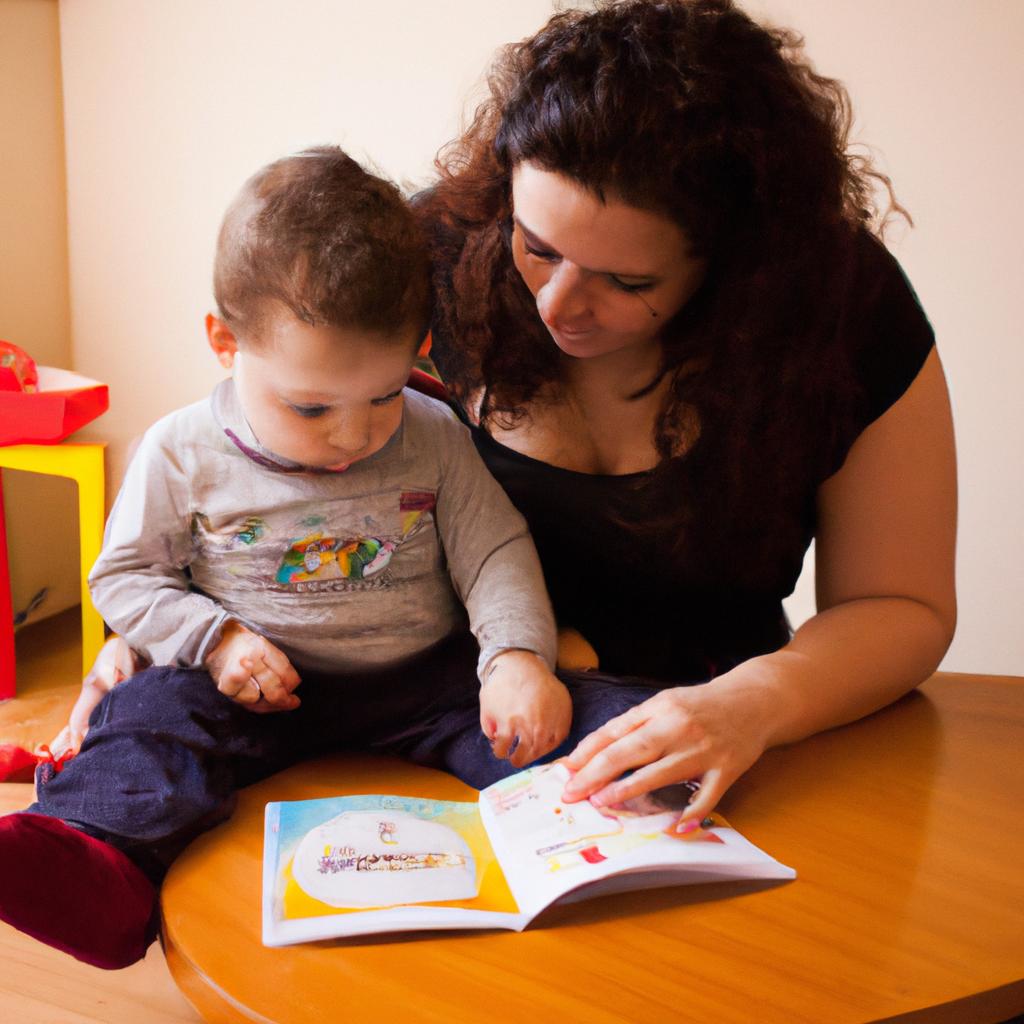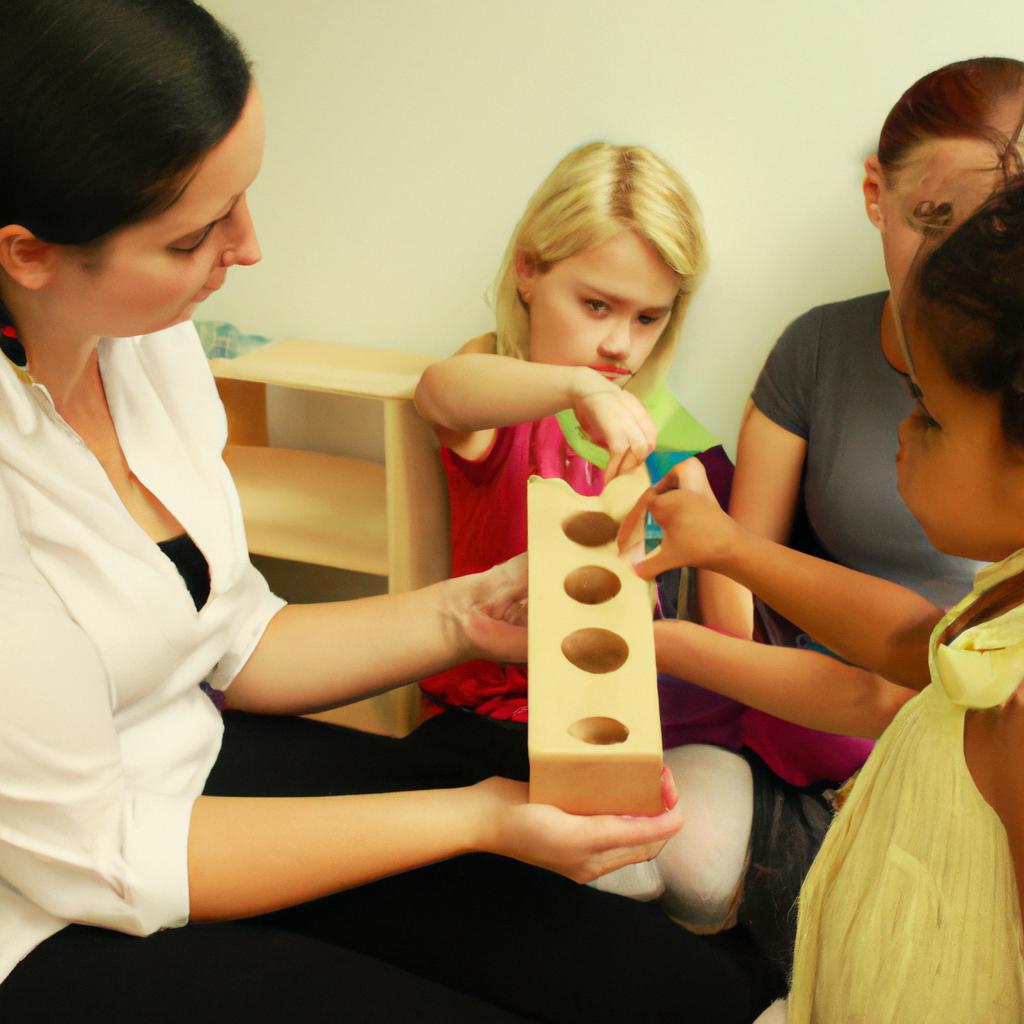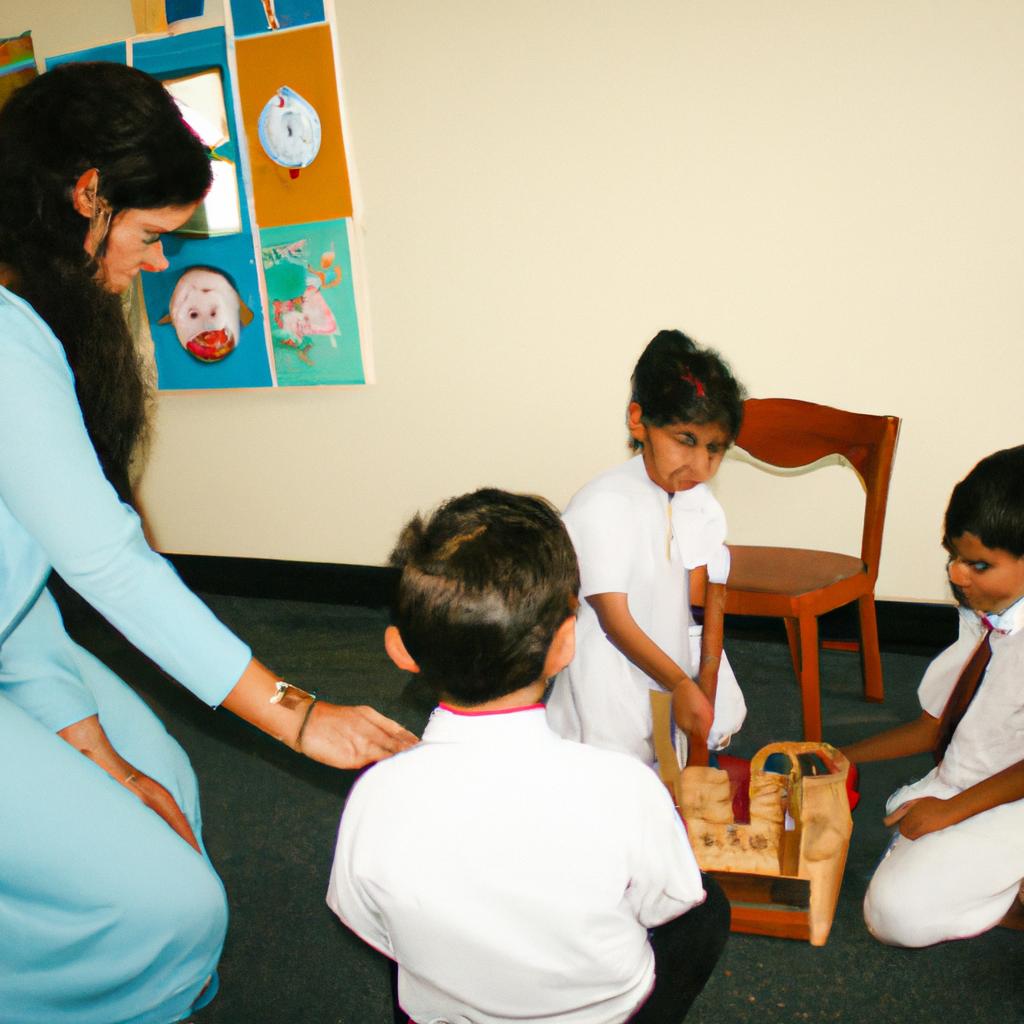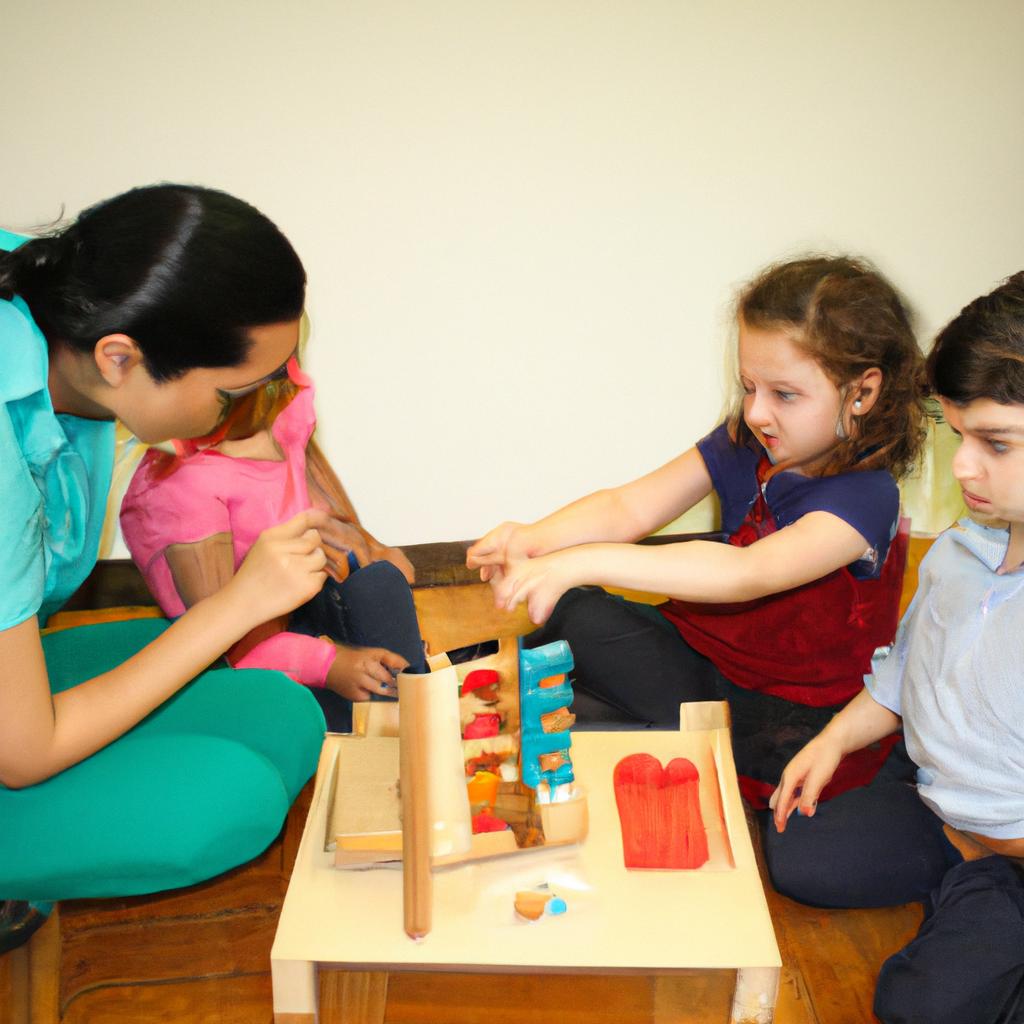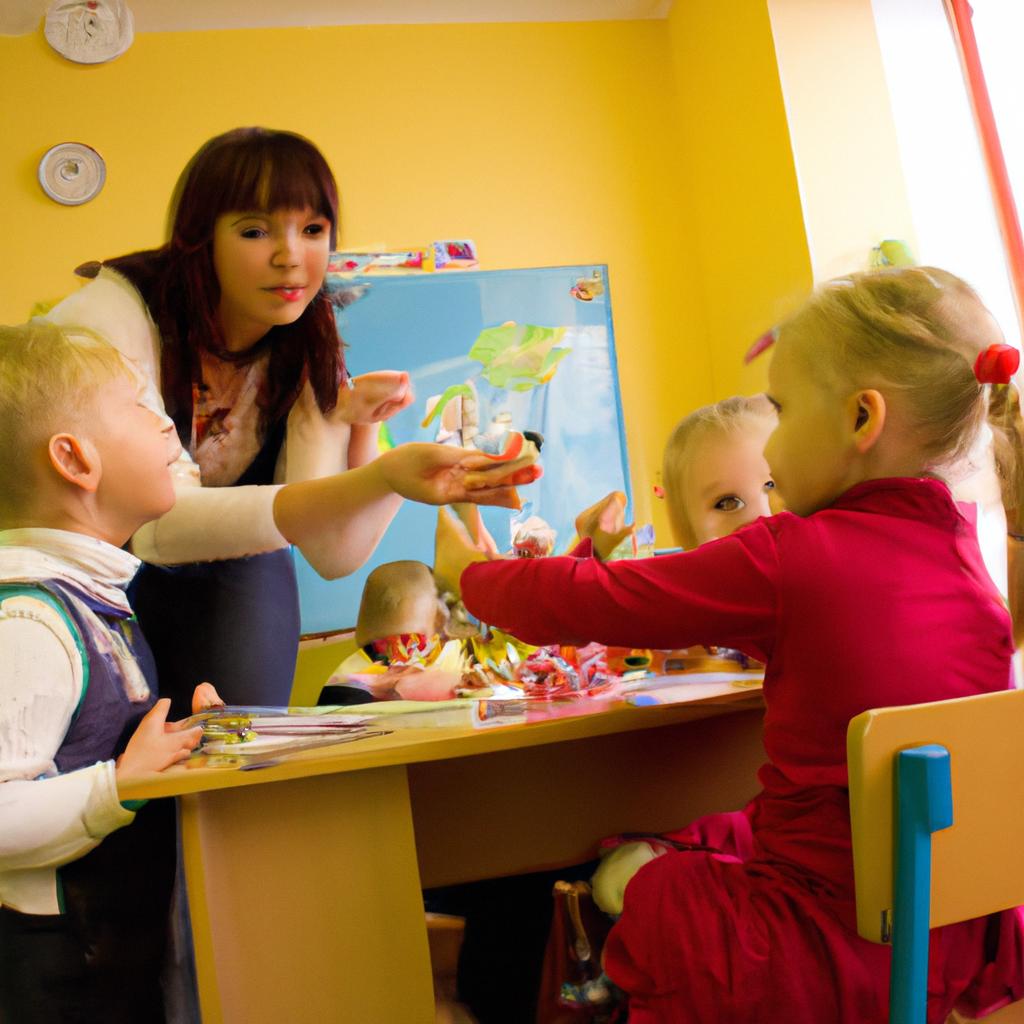In the realm of Montessori education, mixed-age classrooms have gained recognition for their unique approach to student learning. Unlike traditional single-grade classrooms, mixed-age classrooms bring together students from different age groups, allowing them to interact and collaborate in a diverse social setting. For instance, imagine a hypothetical scenario where a five-year-old child named Emma is placed in a classroom with children ranging from three to six years old. In this environment, Emma not only learns academic concepts but also develops valuable skills such as empathy, leadership, and cooperation through her interactions with both younger and older peers.
The benefits of mixed-age classrooms extend beyond social development and encompass various aspects of academic growth as well. Research has shown that when students are exposed to a range of ages within the same class, they experience enhanced cognitive stimulation and engagement. The presence of older students provides younger learners with role models who can guide them in their academic journey, while younger students offer fresh perspectives that challenge older ones to think critically and reflect on their own knowledge. Additionally, mixed-age classrooms promote individualized instruction by allowing teachers to tailor lessons based on each student’s unique abilities and progress levels rather than adhering strictly to grade-level standards. Through these dynamics, mixed-age classrooms foster an inclusive learning environment that supports the holistic development of each student.
In a mixed-age classroom, students have the opportunity to develop a deeper understanding of concepts as they engage in peer-to-peer teaching and collaborative problem-solving. Older students can reinforce their own knowledge by explaining concepts to younger peers, which enhances their mastery of the subject matter. On the other hand, younger students benefit from exposure to more advanced concepts and are motivated to challenge themselves in order to keep up with their older classmates. This dynamic promotes a sense of mutual respect and support among students, fostering a positive learning environment where everyone feels valued and included.
Furthermore, mixed-age classrooms promote self-directed learning and independence. As students progress through multiple years in the same classroom, they develop a sense of ownership over their education. They become accustomed to setting goals, managing their time effectively, and taking responsibility for their own learning. This not only prepares them for future academic endeavors but also instills valuable life skills that extend beyond the classroom.
In summary, mixed-age classrooms offer numerous benefits for student development across various domains – social, emotional, cognitive, and academic. By bringing together students of different ages in an inclusive learning environment, these classrooms foster collaboration, empathy, critical thinking skills, and individualized instruction. Montessori education recognizes and embraces the unique potential that mixed-age classrooms hold in nurturing well-rounded individuals who are prepared for success in both academic pursuits and interpersonal relationships.
Enhanced social skills development
One of the prominent benefits of mixed-age classrooms in Montessori education is the enhanced development of students’ social skills. By placing children of different ages together, these classrooms create a natural and dynamic environment for social interaction. For instance, consider a hypothetical case study involving Sara, a 5-year-old student, and Emma, an 8-year-old student. In this scenario, Sara may look up to Emma as a role model and seek guidance from her on various academic tasks or daily activities. This interdependence fosters mutual respect, collaboration, and empathy among the students.
In addition to fostering positive relationships between older and younger peers, mixed-age classrooms provide numerous opportunities for children to develop essential social skills through their interactions with diverse individuals. A markdown bullet point list illustrates some key aspects:
- Empathy: Students learn to understand and appreciate others’ perspectives by regularly interacting with classmates who have varying life experiences.
- Conflict resolution: Through resolving conflicts that naturally arise in group settings, students acquire valuable problem-solving skills and strategies.
- Peer mentoring: Older students often act as mentors to younger ones, assisting them in developing new concepts or acquiring specific skills.
- Cooperative learning: Collaborative projects enable students to work together towards common goals while contributing their unique strengths.
Furthermore, research suggests that mixed-age classrooms facilitate the acquisition of prosocial behaviors such as sharing, cooperating, and taking turns more effectively than single-grade classrooms (Johnson & Johnson, 1991). These findings highlight how the social dynamics within mixed-age environments can positively impact overall character development.
In conclusion transitioning into the subsequent section about “Improved self-confidence,” it is evident that mixed-age classrooms offer exceptional opportunities for enhancing students’ social skills through peer interactions and collaborative learning experiences. Next, we will explore how these inclusive educational settings contribute to improved self-confidence among learners.
Improved self-confidence
Enhanced social skills development in mixed-age classrooms is just one of the many benefits that students can experience. Another advantage lies in the improved self-confidence they gain through their interactions with peers of different ages and abilities.
For instance, consider a hypothetical case study where an introverted child named Emma enters a Montessori mixed-age classroom for the first time. Initially, she feels shy and unsure about interacting with others. However, as she observes her older peers engaging in activities confidently and assisting younger children, she gradually begins to participate more actively herself. Through these interactions, Emma learns to communicate effectively, negotiate conflicts peacefully, and develop empathy towards others.
- Increased opportunities for collaboration: Students engage in cooperative learning experiences by working together on projects or tasks.
- Learning from peer role models: Younger children often look up to older classmates as mentors and learn valuable lessons from them.
- Enhanced problem-solving abilities: Students are exposed to diverse perspectives when resolving issues, fostering critical thinking skills.
- Greater sense of community: A supportive environment is created where students feel valued and connected to their peers.
To demonstrate this concept visually, we can incorporate a table showcasing how different age groups benefit from mixed-age classrooms:
| Age Group | Benefits |
|---|---|
| Younger Children (e.g., 3-4 years old) | – Learn from observing older students- Receive guidance and support from older peers |
| Middle-Aged Children (e.g., 5-7 years old) | – Develop leadership qualities by helping younger classmates- Gain confidence through mentoring roles |
| Older Children (e.g., 8-12 years old) | – Reinforce knowledge by teaching concepts to younger learners- Enhance communication skills through explaining ideas |
In summary, the enhanced social skills development experienced within mixed-age classrooms contributes to improved self-confidence among students. Through observing and interacting with peers of different ages, children like Emma can gradually develop their social abilities in a supportive learning environment. These benefits extend beyond the classroom, fostering empathy, collaboration, and problem-solving skills that will benefit them throughout their lives.
Transitioning into the subsequent section on “Individualized learning experiences,” we can explore how mixed-age classrooms facilitate personalized educational journeys for students.
Individualized learning experiences
Following the enhanced self-confidence that students gain in mixed-age classrooms, another significant advantage is the promotion of peer mentoring. In these environments, older students have the opportunity to serve as mentors and role models for their younger peers. For instance, imagine a scenario where a 10-year-old student named Emily excels in mathematics and has been designated as a mentor for a 7-year-old classmate named Ethan who struggles with the subject.
This approach fosters an atmosphere of collaboration and support among students, promoting positive social interaction and empathy. Through peer mentoring, students develop critical skills such as communication, leadership, patience, and understanding. This not only benefits the mentees but also helps foster personal growth for those serving as mentors.
To emphasize the advantages of peer mentoring further, consider the following bullet points:
- Encourages teamwork and cooperation.
- Fosters a sense of responsibility.
- Enhances problem-solving abilities through shared learning experiences.
- Builds strong bonds between classmates.
Moreover, incorporating peer mentoring into mixed-age classrooms can be facilitated by creating structured opportunities for collaboration. A table below illustrates some effective strategies utilized in Montessori education:
| Strategies for Promoting Peer Mentoring |
|---|
| Regular small-group activities |
| Cross-grade buddy systems |
| Collaborative projects |
| Joint presentations |
Implementing these strategies cultivates an environment where older students take on leadership roles while younger ones benefit from their guidance. As they work together towards common goals or engage in joint initiatives, both parties learn valuable lessons about respect, empathy, and inclusivity.
Promotion of peer mentoring encourages mutual respect amongst learners by highlighting individual strengths within each age group. By providing opportunities for older students to guide their younger counterparts academically and socially, mixed-age classrooms create an enriching educational experience that transcends traditional grade-based divisions.
The next section will explore the benefits of individualized learning experiences within mixed-age classrooms.
Promotion of peer mentoring
Building upon the individualized learning experiences in mixed-age classrooms, another advantage lies in the promotion of peer mentoring. This collaborative approach to education fosters a supportive environment where students learn from and support one another.
Peer mentoring is exemplified by scenarios such as an older student assisting a younger peer in mastering a challenging math concept or guiding them through a complex science experiment. For instance, let us consider the case study of a 10-year-old student named Emily who struggled with reading comprehension. In a mixed-age classroom, her peers provided guidance and encouragement, sharing their own strategies for understanding texts effectively. Consequently, Emily’s reading skills improved significantly, thanks to the assistance she received from her classmates.
The benefits of peer mentoring within mixed-age classrooms are numerous:
- Enhanced academic performance: Peer mentoring allows students to reinforce their knowledge by teaching others. The act of explaining concepts to someone else helps deepen their own understanding.
- Increased self-confidence: Younger children often look up to older students as role models. By providing guidance and support, older peers help boost the confidence of younger students, enabling them to take risks and explore new ideas without fear.
- Improved social skills: Collaborating with peers from different age groups enhances communication skills and encourages empathy. Students learn how to resolve conflicts constructively while developing tolerance and respect for diverse perspectives.
- Sense of belonging: Through meaningful interactions with peers across multiple age levels, students develop strong bonds that foster a sense of community within the classroom.
Table: Benefits of Peer Mentoring in Mixed-Age Classrooms
| Benefits | Description |
|---|---|
| Academic growth | Reinforces knowledge through teaching |
| Confidence building | Boosts self-assurance and encourages risk-taking |
| Social skill development | Enhances communication abilities while promoting empathy |
| Strong sense of community | Fosters feelings of belonging and connection among students |
In conclusion, peer mentoring in mixed-age classrooms provides students with invaluable opportunities to learn from one another. This collaborative approach not only enhances academic performance but also promotes self-confidence and the development of social skills. By fostering a sense of community within the classroom, these interactions create a supportive environment where all students feel valued and included.
Furthermore, mixed-age classrooms contribute to the fostering of empathy and understanding among students.
Fostering of empathy and understanding
Promotion of peer mentoring has been identified as one of the key advantages in mixed-age classrooms within Montessori education. By bringing together students from different age groups, opportunities for peer mentoring and learning are enhanced. For instance, consider a hypothetical scenario where a 10-year-old student struggling with math concepts is paired with a 12-year-old classmate who excels in mathematics. The older student can serve as a mentor, providing guidance and support to their younger counterpart.
One significant benefit of promoting peer mentoring is that it fosters a sense of responsibility and leadership among older students. When they assume the role of mentors, they develop valuable communication and problem-solving skills while reinforcing their own knowledge. This experience empowers them to take on leadership roles not only inside the classroom but also in other aspects of life.
- Students gain exposure to diverse perspectives.
- Collaboration becomes intrinsic rather than forced.
- Children learn to celebrate differences instead of viewing them as barriers.
- Peer mentoring promotes inclusivity by breaking down social hierarchies.
To emphasize the impact of these benefits, we can present a table showcasing specific instances where peer mentoring facilitates positive outcomes:
| Scenario | Outcome |
|---|---|
| Younger student struggling with math | Older student provides personalized tutoring |
| Shy student lacking self-confidence | Peer encouragement boosts self-esteem |
| New student adjusting to the school | Mentor helps integrate into the classroom |
| Student experiencing emotional issues | Supportive peers provide comfort and friendship |
In conclusion, promotion of peer mentoring within mixed-age classrooms offers numerous advantages for students in Montessori education. Through real-life examples and hypothetical scenarios, we have seen how this approach nurtures responsibility, leadership skills, empathy, and understanding. In the subsequent section about “Preparation for real-world diversity,” we will explore another significant benefit of mixed-age classrooms.
Preparation for real-world diversity
Transitioning from the fostering of empathy and understanding within mixed-age classrooms, another significant advantage lies in the preparation it provides for real-world diversity. By encompassing students of various ages and abilities, these classrooms create an environment that mirrors the diverse nature of society, preparing students to navigate a world filled with individuals who possess different perspectives, backgrounds, and experiences.
To better understand this advantage, let’s consider a hypothetical case study involving two students: Emily and Jacob. Emily is a 9-year-old student who excels academically but struggles with social skills due to her introverted nature. In contrast, Jacob is a 12-year-old student who performs average academically but possesses exceptional leadership qualities. Within a traditional age-segregated classroom setting, both Emily and Jacob may have limited opportunities to interact or collaborate with each other due to their age differences. However, in a mixed-age Montessori classroom, they would have frequent interactions as they work together on projects or engage in peer-to-peer teaching and learning activities.
This exposure to peers with varying strengths and weaknesses fosters adaptability and flexibility in children as they learn to appreciate individual differences. To further illustrate its impact, here are some key benefits associated with mixed-age classrooms:
- Increased tolerance: Interacting regularly with classmates of different ages cultivates empathy and respect for others’ unique perspectives.
- Enhanced communication skills: Students develop effective communication strategies when collaborating across different age groups.
- Strengthened problem-solving abilities: Working alongside peers of varying skill levels promotes critical thinking by encouraging students to tackle challenges collectively.
- Boosted self-confidence: Younger learners gain confidence through observing older students while older ones develop leadership skills by acting as role models.
Moreover, research has shown that mixed-age classrooms provide numerous advantages beyond those mentioned above. Consider the following table summarizing additional benefits observed among students enrolled in such educational settings:
| Benefits of Mixed-Age Classrooms |
|---|
| Enhanced social development |
| Improved self-regulation skills |
| Increased motivation and engagement |
| Greater academic growth |
In conclusion, mixed-age classrooms in Montessori education not only foster empathy and understanding but also actively prepare students for the diverse realities they will encounter beyond the classroom walls. By offering opportunities to collaborate with peers of varying ages and abilities, these classrooms equip children with essential life skills such as adaptability, tolerance, effective communication, problem-solving capabilities, and bolstered confidence. The advantages extend far beyond the immediate educational setting, ensuring that students are well-prepared to thrive in a world characterized by real-world diversity.


